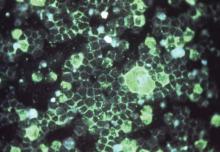Pediatricians and our teams are the immunization experts. We educate, advocate, and incorporate vaccines into much of our daily routine. As such, we recognize the importance of working with our colleagues in family medicine, internal medicine, and obstetrics to optimize immunization programs for high-risk individuals, including pregnant women. Recent advances in vaccine recommendations during pregnancy are a result of the collaborative efforts of the health care providers for these women, and from systematic evaluation of immunization programs, vaccine pregnancy registries, and disease epidemiology.
Vaccinating women during pregnancy should be considered when a vaccine is known to be safe and when the following apply:
• The risk of severe infection is high during or augmented by pregnancy.
• The specific infection during pregnancy threatens the fetus.
• Maternal protection against infection benefits the newborn.
• Passive transfer of antibody from mother to fetus benefits the newborn.
Examples of safe vaccines immediately come to mind that fulfill one of more of these criteria, yet substantial obstacles exist even where safety and effectiveness data are robust. Because clinical vaccine trials traditionally exclude pregnant women, safety and effectiveness data for this group and their newborns are limited and often must come through experience. In a climate of increased vaccine hesitancy in general, both among providers and patients, vaccine delivery can be fragmented and particularly difficult to streamline. Additional obstacles that exist for any immunization program, including one that targets pregnant women specifically, are immunization delivery logistics and cost.
One of the major success stories of maternal immunization that is easily forgotten or overlooked in developed parts of the world is in the prevention of maternal and neonatal tetanus (MNT). A review of recent history reminds us that between the years 2000 and 2014, 35 countries were finally successful in eliminating MNT, including China, Turkey, Egypt, and South Africa. In addition, 24 of 36 states in the country of India, 30 of 34 provinces of Indonesia, and most of Ethiopia have met with success. This has been accomplished through aggressive tetanus vaccination programs, and through education programs targeted at optimal umbilical cord stump care after delivery.
In the United States, the Advisory Committee on Immunization Practices recommends that all pregnant women should receive inactivated influenza vaccine and Tdap vaccine. In addition, several other vaccines are recommended under certain circumstances. Live attenuated vaccines are considered contraindicated, although yellow fever vaccine is an exception during epidemics, or when travel to a highly endemic area during pregnancy cannot be avoided.
Influenza vaccine administered during pregnancy reduces maternal morbidity and mortality. Moreover, safety and benefits for the fetus are clearly documented. Both retrospective cohort analysis studies and randomized controlled trials have consistently demonstrated lower risk of preterm birth and lower risk for delivering newborns small for gestational age among women who received inactivated influenza vaccine during pregnancy. The benefit extends to term healthy infants who are less likely to be hospitalized during the first months of life if their mother was vaccinated against influenza during pregnancy. Because the mother was immunized during pregnancy, it reduces her risk of infection, thereby reducing the potential that the newborn will be exposed to a mother who is contagious. Perhaps more importantly, infants born at or near term have the benefit of transplacental antibody endowment from their mother, including vaccine induced anti-influenza antibodies. This passive protection is expected to last for several months. Active immunization against influenza during infancy begins at 6 months of age.
Tdap vaccine is also recommended during each pregnancy. In the United States, MNT is eliminated. Here, as in other developed countries, Tdap is administered to reduce infant pertussis morbidity. Pertussis remains endemic to the United States, and infants who develop whooping cough during the first 2-3 months of life are at the highest risk for morbidity and mortality.
Historically, one-third of infants infected with pertussis were infected by their mother, although more recent evidence suggests that older siblings are at least as likely a source. Looking back to the paradigm for protection against influenza infection in the first few months of life, it becomes clear why the Advisory Committee on Immunization Practices of the Centers for Disease Control and Prevention has recommended Tdap vaccine for all mothers during each pregnancy.
The first goal is to prevent pertussis in the mother so that she will not transmit the infection to her newborn. The additional goal, and the rationale for vaccinating pregnant women during every pregnancy, is to optimize levels of anti-pertussis antibody in the mother, so that the transplacental endowment to the infant is as robust as possible.



